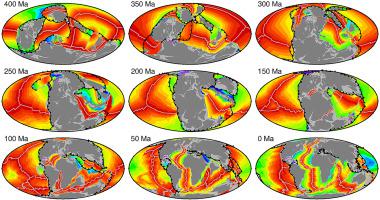Geoscience Frontiers ( IF 8.9 ) Pub Date : 2020-07-16 , DOI: 10.1016/j.gsf.2020.06.004 Simon Williams , Nicky M. Wright , John Cannon , Nicolas Flament , R. Dietmar Müller

|
Reconstructions of past seafloor age make it possible to quantify how plate tectonic forces, surface heat flow, ocean basin volume and global sea level have varied through geological time. However, past ocean basins that have now been subducted cannot be uniquely reconstructed, and a significant challenge is how to explore a wide range of possible reconstructions. Here, we investigate possible distributions of seafloor ages from the late Paleozoic to present using published full-plate reconstructions and a new, efficient seafloor age reconstruction workflow, all developed using the open-source software GPlates. We test alternative reconstruction models and examine the influence of assumed spreading rates within the Panthalassa Ocean on the reconstructed history of mean seafloor age, oceanic heat flow, and the contribution of ocean basin volume to global sea level. The reconstructions suggest variations in mean seafloor age of ~15 Myr during the late Paleozoic, similar to the amplitude of variations previously proposed for the Cretaceous to present. Our reconstructed oceanic age-area distributions are broadly compatible with a scenario in which the long-period fluctuations in global sea level since the late Paleozoic are largely driven by changes in mean seafloor age. Previous suggestions of a constant rate of seafloor production through time can be modelled using our workflow, but require that oceanic plates in the Paleozoic move slower than continents based on current reconstructions of continental motion, which is difficult to reconcile with geodynamic studies.
中文翻译:

重建失落海盆中的海底年龄分布
过去海底年龄的重建使人们有可能量化板块构造力,地表热流,海盆体积和全球海平面如何随地质时间而变化。然而,现在已经俯冲的过去的海盆无法唯一地重建,而一个重大挑战是如何探索各种可能的重建方法。在这里,我们使用已发布的全盘重建和新的高效海底年龄重建工作流程,研究了从古生代到现在的海底年龄分布,所有这些工作都是使用开源软件GPlates开发的。我们测试了替代重建模型,并检验了Panthalassa海洋中假定的扩散速度对重建平均海底年龄,海洋热流以及海盆体积对全球海平面的贡献的影响。重建结果表明,在古生代晚期,平均海底年龄约为15 Myr,与先前为白垩纪提出的变化幅度相似。我们重建的海洋年龄区域分布与这样一种情况基本兼容:在这种情况下,自古生代以来晚期全球海平面的长期波动在很大程度上是由平均海底年龄的变化驱动的。可以使用我们的工作流程来建模以前关于海底生产随时间保持恒定速率的建议,

























 京公网安备 11010802027423号
京公网安备 11010802027423号